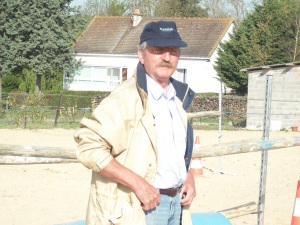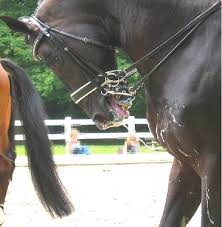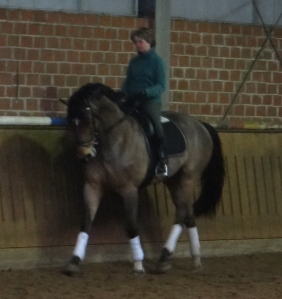Often during the many long years of dressage training, my instructor would be away for periods of time, either off to Europe to “recharge his batteries” or to some university to further his own training. So the questions is this: What do students do when the “cat’s away”? If we have an instructor with a unique teaching style we don’t want to seek out another coach so what do we do?
Speaking for myself, in the initial days and weeks I just had fun. Being free from watchful eyes, and often disapproving ones, I took advantage of this opportunity to play with all I thought I had learned. It was exhilarating to play with the movements, push for more power and fancy strides. I imagined I was riding full of expression, utilizing all my skills to a degree I wasn’t permitted to under supervision.
And then, as happens, things began to turn a little sour. My horse was more resistant, while fully forward going as was his nature, he was not through and eventually became quite tense. In my “fun” and imagined accomplishments, I began to realize he was no longer supple and relaxed. In my enthusiasm I had overridden to such a degree that I was forcing the work, not developing it. I became frustrated as to why things were deterioriating and probably, given my driven nature, I was creating tension through insisting to my horse that I was “right”. I think the penny dropped one restless night around 3 a.m. that I was making a mess, and I suddently realized why, and how. So the next morning as I prepared my horse for a new start, I apologized to him and thanked him profusely for not trying kill me, as he was a bit of an overactor himsself. Not always a good combination.
I started back with a new attitude and understanding. Back to basics, the exercises I had grown so tired of, and felt weren’t all that necessary in my desire to “quit the scales and play some music”. So I returned to all the suppling exercises, worked on relaxation, rhythm, throughness, all with thought, focus, preparation and planning. And to my surprise, as things began to improve and I was aware of what I wanted to do, and was trying to accomplish, I realized that I was actually having fun. And rather than feeling frustrated, was beginning to find some satisfaction in the “simple” things. It was at this point, I was looking forward to the return of my coach.
Now that I’m on a new endeavour, one less physically demanding, but no less mentally so, I am once again finding parallels. In my quest to learn art, specifically watercolor, which I find very intriguing, I have come upon the same dilemma. Due to the many factors of the times, restrictions related to COVID and the hesitation of people to meet, it has become more and more difficult to form a group to pursue our lessons. And of course even instructors have reservations, so I find myself without an instructor once again. So what am I doing?
I suppose some people never learn, or maybe it’s just my over enthusiastic or overly confident character, that I found myself in the same trap. For the initial several weeks of being on my own, guess what? I had fun. I was “off to the races” with a paint brush. I wanted to do everything I thought I had learned. I threw caution to the wind (which means I went through a lot of expensive watercolor paper) trying to duplicate those things I’d seen my instructor do so easily. I worked from pictures, my imagination, and tried duplicating some of the work from my instructor. I challenged my knowledge and abilities with brushes, pigments and water. And as the trash can continued to fill, and overflow, I came to the realisation that all I was doing was making one mess after the other. Somehow it seems to take a disaster to slow me down, and a review of reems of paper, most headed to waste, brought home the fact, I was missing the point, as I had with riding. It was a major reality check. I came to realize I was not engaging my brain, as I had been told more than once by the powers that be.
I had spent hours and hours watching my instructor work over a period of almost two years, and it suddenly occurred to me that I rarely saw him complete a full piece of art. On a random outing or two where we were painting as a group, he may have completed a landscape. But, for the most part, his work consisted of simple exercises he would demonstrate to us. It formed a complete simple painting, I now realize, meant to encourage us to make use of exercises to learn, and demonstrating to us how those exercises, those pieces, formed a whole. Somehow the penny dropped in this circumstance late at night as well. That’s when our frustrations keep us awake, and we do our best thinking, well sometimes.

Basic wash
Maintaining puddle of paint
So with this thought in mind, I literally went back to the drawing board. I went back to basics, the washes, the mixing of pigment and water, thinking of consistency relative to the project, selection of brushes and being aware of loading the brush sufficiently. I did what had become laborious exercises with a fresh understanding and approach. I thought about what I was about to do, planning ahead, and taking into consideration the purpose of what I was doing. And, as before with my horse, it became challenging in a way I enjoyed. I began to look forward to doing those exercises, and realized that a picture is actually a combination of those exercises, just as basics in dressage were the precursor to the movements. And in doing so, I make another very interesting discovery. I discovered that art requires feel, just like riding is based on feel. It surprised me to realize brushes can feel different in our hand, that how you hold them has an impact on how you use them, and that paper has a palpable texture, which can be felt with the right touch. It struck me how similar that is with the fact that a fine contact with a horse’s mouth is the best communication, and the best results in art come with a fine feel in the artist’s touch. And, as in riding, pressure varies and that variance produces varying results.
So, I’ve once again learned a lesson about myself. Patience yields rewards. And I’ve been reminded of the fact that without the basics, in either endeavour, be it riding are watercolor, the finished product is lacking. Striving for perfection requires endless practice, but practice is wasted when it is thoughless and hurried. I’m learning this lesson, though I realize I’ll have lapses, it’s my driven nature. However, I am proceding as I write with a more thoughtful and careful approach, We’re never too old to learn, or change.




























